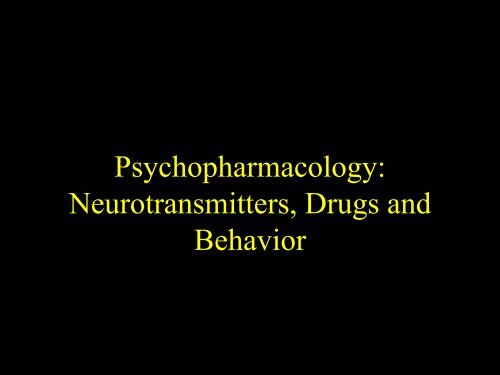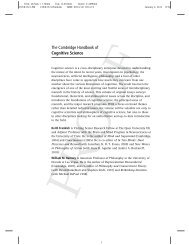Psychopharmacology: Neurotransmitters, Drugs and Behavior
Psychopharmacology: Neurotransmitters, Drugs and Behavior
Psychopharmacology: Neurotransmitters, Drugs and Behavior
Create successful ePaper yourself
Turn your PDF publications into a flip-book with our unique Google optimized e-Paper software.
<strong>Psychopharmacology</strong>:<br />
<strong>Neurotransmitters</strong>, <strong>Drugs</strong> <strong>and</strong><br />
<strong>Behavior</strong>
A quick review of synaptic action<br />
• receptor types (ionotropic <strong>and</strong><br />
metabotropic)<br />
• receptor subtypes
Being a neurotransmitter: What<br />
does it take?<br />
• Exists presynaptically<br />
• Synthesis enzymes exist presynaptically<br />
• Released in response to action potential<br />
• Postsynaptic membrane has receptors<br />
• Application at synapse produces response<br />
• Blockade of release stops synaptic function
The classical neurotransmitters<br />
•Amines<br />
– Monoamines<br />
• catecholamines (dopamine, noradrenaline)<br />
• indoleamines (serotonin, melatonin)<br />
– Quaternary amines<br />
• acetylcholine<br />
• amino acids (glutamate, GABA)
Catecholamine synthesis<br />
-this is not for torture<br />
-underst<strong>and</strong>ing synthesis<br />
can be important for<br />
underst<strong>and</strong>ing drug action
Catecholamines<br />
Dopamine<br />
Subtantia nigra <strong>and</strong><br />
Parkinson’s disease<br />
Mesocorticolimbic<br />
system <strong>and</strong><br />
schizophrenia<br />
Receptor specificity
Catecholamines<br />
Noradrenergic pathways in the brain<br />
-locus coeruleus
Serotonin synthesis
Serotonin<br />
Serotonergic pathways in the brain<br />
-raphe, 15 subtypes, Prozac <strong>and</strong> depression
Acetylcholine synthesis
Acetylcholine<br />
Cholinergic pathways in the brain<br />
-basal forebrain, neuromuscular junction
Amino acids: The workhorses of<br />
the neurotransmitter family<br />
Glutamate - the primary excitatory neurotransmitter in brains<br />
GABA (Gamma-amino-butyric-acid) - the primary inhibitory<br />
neurotransmitter
The fabulous glutamate receptor<br />
Activation of NMDA receptor can cause changes in the<br />
numbers of AMPA receptors – a mechanism for learning?
The fabulous GABA receptor<br />
Multiple binding sites
Peptides<br />
•Produced in minute quantities<br />
•often substances that are also found in areas of<br />
body other than brain (vasoactive intestinal<br />
polypeptide)<br />
•tremendously potent <strong>and</strong> long-acting<br />
(neuromodulatory)<br />
•opiates
The opiate story<br />
•Opiates have been used for centuries to<br />
relieve pain<br />
•Pert <strong>and</strong> Snyder found that opiates bind to<br />
receptors in several areas<br />
•not until 1975 did we know of endogenous<br />
opioids<br />
•several varieties of receptors
What is a ‘drug’?<br />
• A very vague term<br />
• all ingested substances alter bodily function<br />
• ‘drug’ is reserved for things that have<br />
pronounced effects when ingested in small<br />
quantities
Basic classification of drug<br />
actions<br />
• Agonists stimulate or activate<br />
• antagonists prevent
Ways that drugs can agonize<br />
• Stimulate release<br />
• receptor binding<br />
• inhibition of reuptake<br />
• inhibition of deactivation<br />
• promote synthesis
Ways that drugs can antagonize<br />
•Block release<br />
• receptor blocker<br />
• prevent synthesis
Schizophrenia<br />
Affects about 1/100 people<br />
Begins in 20’s<br />
Often triggered by stress, illness, etc.<br />
but there’s also a genetic<br />
predisposition
Symptoms of schizophrenia<br />
Positive symptoms<br />
-hallucinations, delusions, paranoia<br />
Negative symptoms<br />
-lack of emotion, energy, directedness
The dopamine theory of<br />
schizophrenia
Competitive binding
Clinical effectiveness of antipsychotics<br />
vs their effectiveness in binding to<br />
dopamine receptors
Dopamine receptors in normals<br />
<strong>and</strong> schizophrenics
Beyond dopamine<br />
New generation antipsychotics affect<br />
serotonin as well<br />
Glutamate antagonists can help with negative<br />
symptoms<br />
Schizophrenia likely affects a host of systems<br />
perhaps by disturbing a fundamental balance<br />
among neurotransmitters
Alzheimer’s Disease<br />
First described by Alois Alzheimer in 1907<br />
Course of disease:<br />
-initially, some memory loss (new<br />
memories <strong>and</strong> disorientation<br />
-relentlessly progressive until one<br />
loses identity
Neuropathology in Alzheimer’s<br />
disease
Neurofibrillary tangles<br />
Silver stain<br />
Paired helical filaments
Formation of NFT’s
Amyloid plaques
Formation of amyloid plaques<br />
Amyloid precursor protein
Formation of amyloid plaques
Formation of amyloid plaques
In addition….<br />
Massive loss of synapses in cortex<br />
Mild<br />
Moderate<br />
Severe
Basal forebrain involvement<br />
Nucleus basalis of Meynert
Causes<br />
Largely unknown<br />
-Down’s syndrome link<br />
-but strongly inherited forms account for<br />
only small proportion<br />
-plaques seen in wide variety of<br />
disorders acquired by disease<br />
(encephalitis, CJD) <strong>and</strong> accident (punchdrunk<br />
syndrome)
Treatments<br />
1. ‘Cognitive enhancers’<br />
-Acetylcholinesterase inhibitors to<br />
offset loss of cholinergic neurons<br />
2. NMDA antagonists<br />
-Memantine<br />
-idea here is that part of problem in<br />
AD is that chronic release of<br />
glutamate prevents NMDA receptors<br />
from working properly



